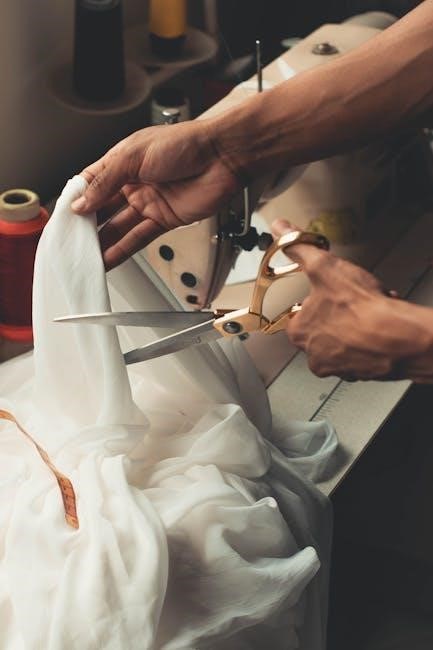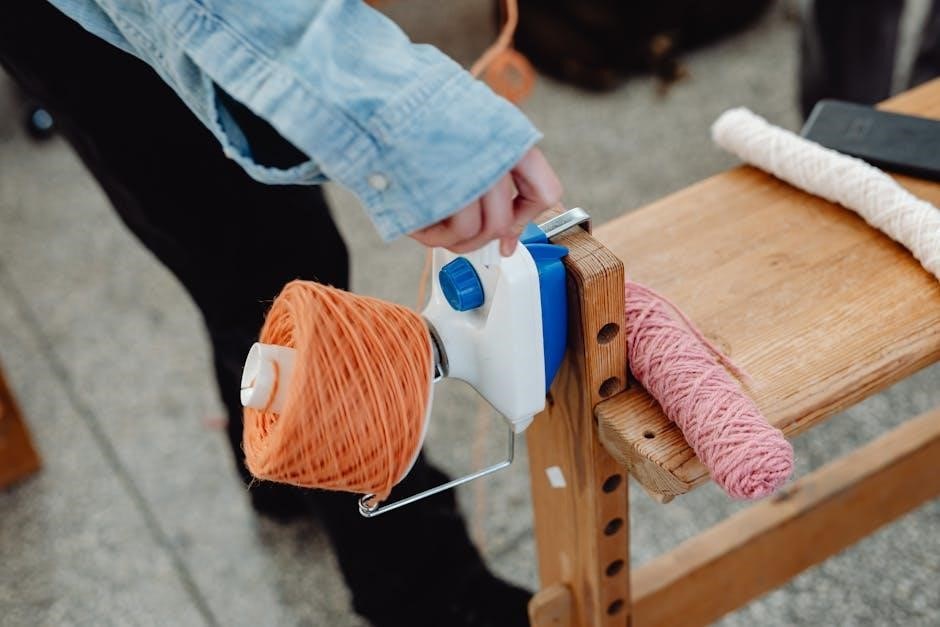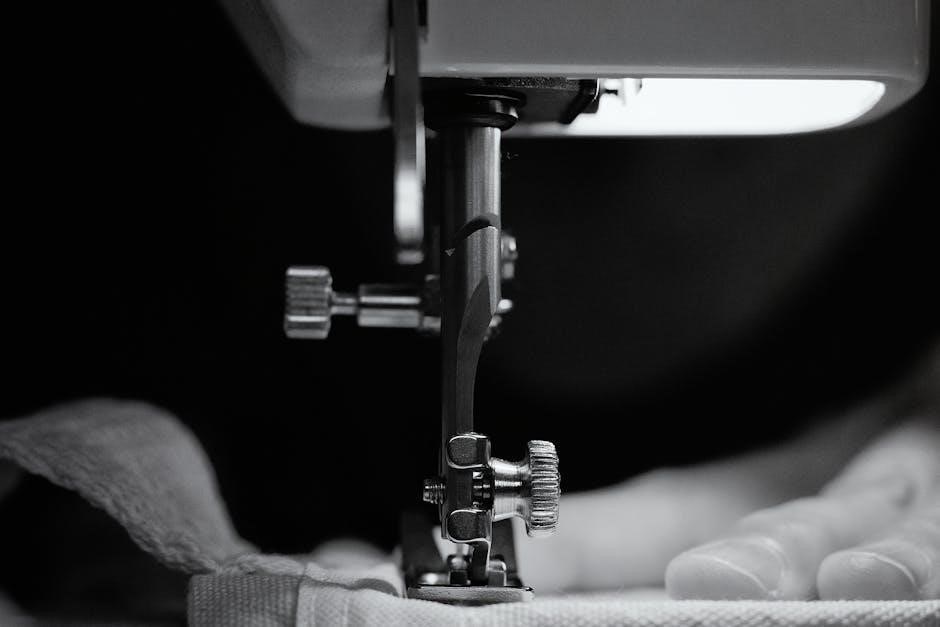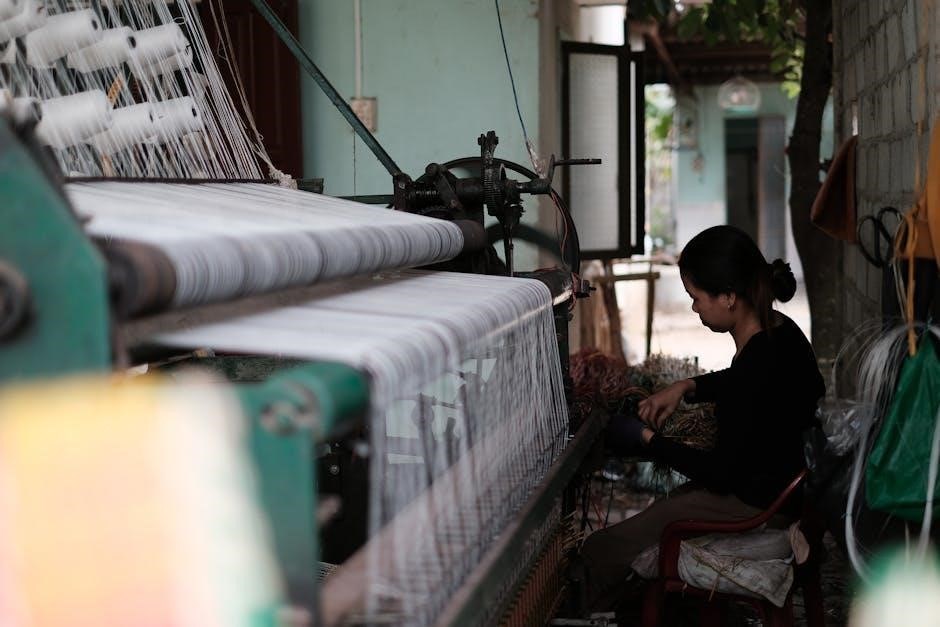The Brother Sewing Machine Instruction Manual is a comprehensive guide for users to understand and operate their sewing machines effectively. It provides detailed instructions on safety, setup, threading, and troubleshooting, ensuring optimal performance and longevity of the machine.
Understanding the Importance of Reading the Manual
Reading the Brother Sewing Machine Instruction Manual is essential for safe and effective operation. It provides critical information on setup, threading, and maintenance, ensuring users understand machine capabilities and limitations. Proper guidance helps prevent accidents and prolongs the machine’s lifespan. The manual also offers troubleshooting tips for common issues, saving time and frustration. By following the instructions, users can maximize their sewing experience and achieve professional results. Ignoring the manual may lead to improper use, damage, or unsafe conditions. Always prioritize reviewing the manual before starting any project to ensure a smooth and successful sewing process.

Safety Precautions
Always read the manual before using the machine. Keep children away and avoid loose clothing. Watch the needle carefully and never leave the machine unattended while in operation. Follow all safety guidelines to prevent accidents.
General Safety Warnings
To ensure safe operation of your Brother sewing machine, always follow the general safety guidelines provided in the manual. Keep children and pets away from the machine while it is in use, as moving parts can cause injury. Avoid wearing loose clothing or jewelry that could get caught in the machine. Never leave the machine unattended while it is operating. Keep your work area well-lit and clear of clutter to avoid accidents. Always watch the needle carefully, as it moves rapidly and can cause harm. Do not touch the needle or other sharp parts with your fingers. Use only genuine Brother accessories and parts to maintain safety and performance. Avoid sewing over pins, as this can damage the machine or cause injury. If you notice any malfunction, stop using the machine immediately and refer to the troubleshooting section. By following these precautions, you can ensure a safe and enjoyable sewing experience.
Specific Precautions for Operating the Machine
When operating your Brother sewing machine, adhere to specific precautions to ensure safe and efficient use. Always ensure the machine is placed on a stable, flat surface to prevent vibration or tipping. Use the correct power source as specified in the manual to avoid electrical issues. Keep the machine away from water and moisture to prevent damage or electrical hazards. Never sew near flammable materials, as sparks from the machine could ignite them. Use the reverse sewing lever carefully to avoid accidental stitches. Ensure the presser foot is always in the correct position to prevent fabric from slipping or causing uneven stitching. Regularly inspect and maintain the machine according to the manual’s instructions to prevent mechanical failure. Avoid sewing over loose threads or debris, as this can jam the machine. If you need to sew thick or heavy fabrics, use the appropriate needle and settings recommended by Brother. Always unplug the machine when not in use or during maintenance to ensure safety. By following these guidelines, you can maintain the performance and longevity of your Brother sewing machine while minimizing risks during operation.

Parts and Accessories
Understanding the parts and accessories of your Brother sewing machine is essential for optimal performance. Key components include the needle, bobbin, presser foot, and stitch selectors. Accessories like additional needles, bobbins, and specialized feet enhance versatility for various sewing tasks.
Identifying the Key Components of the Machine
Familiarizing yourself with the key components of your Brother sewing machine is crucial for effective operation. The machine features a needle bar, bobbin case, presser foot, and stitch selector dial. The needle bar holds the sewing needle, while the bobbin case manages the thread supply. The presser foot helps keep fabric steady, and the stitch selector allows you to choose from various stitch patterns. Additional components include the handwheel, reverse stitch lever, and thread take-up lever, each serving specific functions to ensure smooth sewing. Understanding these parts helps you troubleshoot and maintain your machine efficiently. Refer to the manual’s diagrams for a visual guide to locating and identifying each component.
Accessories Included with the Brother Sewing Machine
Your Brother sewing machine comes with a variety of essential accessories to enhance your sewing experience. These include multiple bobbins for winding thread, a set of sewing needles in different sizes, and various presser feet for specialized tasks like zigzag stitching or zipper installation. A screwdriver is also provided for adjusting the machine’s settings, and a seam ripper helps with correcting mistakes. Additionally, some models may include a carrying case for easy transport and storage. The machine often comes with a comprehensive instruction manual, which details how to use each accessory effectively. For more complex projects, optional accessories like embroidery hoops or overlock feet can be purchased separately. Always ensure you use genuine Brother accessories to maintain the machine’s performance and warranty. Refer to the manual for a full list of included items and guidance on their proper use.
Threading and Bobbin
Proper threading and bobbin installation are crucial for smooth sewing. Thread the machine through the spool pin, tension discs, take-up lever, and needle. The bobbin must be correctly wound and placed in the bobbin case to ensure even stitches. Always follow the manual’s guide for accurate setup and troubleshooting.
Step-by-Step Guide to Threading the Machine
Threading the Brother sewing machine requires careful attention to ensure proper operation. Start by turning the machine off and raising the presser foot. Locate the spool pin and draw the thread through the tension discs. Guide the thread through the take-up lever, ensuring it is seated correctly. Next, pass the thread through the needle bar and insert it into the needle eye from front to back. Gently pull the thread to remove any slack. For models like the Brother 1034D, follow the color-coded path for easier threading. Always refer to the manual for specific instructions, as some models may have variations. Proper threading ensures consistent stitch quality and prevents machine jams. If threading becomes difficult, consult the troubleshooting section of the manual or visit the Brother website for additional resources.By following these steps, you can achieve accurate and efficient threading for optimal sewing performance.
Understanding Bobbin Installation and Maintenance
Proper installation and maintenance of the bobbin are crucial for smooth operation of the Brother sewing machine. Begin by selecting the correct bobbin size and type specified in your manual. Insert the bobbin into the bobbin case, ensuring it is seated securely. Hold the end of the top thread and gently pull it to thread the machine. For models like the Brother LS14s, refer to the color-coded diagrams for guidance. Regularly clean the bobbin area to prevent dust buildup, which can cause mechanical issues. Avoid over-tightening the bobbin case, as this may lead to thread breakage. If the bobbin does not spin properly, consult the troubleshooting section of the manual. Proper bobbin maintenance ensures consistent stitching and prevents common sewing errors. Always use the recommended bobbin type for your machine to achieve optimal results. By following these steps, you can maintain your machine’s performance and extend its lifespan.

Basic Sewing Operations
Mastering basic sewing operations ensures efficient and precise stitching. Start by selecting the appropriate stitch type for your fabric. Use the reverse sewing lever for backstitching at the beginning and end of seams. Always watch the needle carefully while sewing to maintain control and avoid accidents. Proper thread tension and fabric alignment are key to achieving professional results. By following these simple steps, you can complete a variety of sewing projects with ease and confidence.
Selecting the Right Stitch Type
Selecting the right stitch type is essential for achieving professional results with your Brother sewing machine. Different fabrics and projects require specific stitches to ensure durability and a polished finish. The Brother sewing machine offers a variety of stitch options, including straight, zigzag, and decorative stitches, each designed for particular tasks. For example, the straight stitch is ideal for general sewing and straight-line projects, while the zigzag stitch is perfect for preventing fraying on raw edges. Decorative stitches add aesthetic value to your work, making them great for embellishments or custom designs.
Always refer to your specific machine’s manual to explore the available stitch options and their recommended uses. Testing stitches on scrap fabric before starting your project ensures the best results. Adjusting stitch length and width can further customize your sewing experience, making it suitable for various materials and needs. By selecting the right stitch type, you can enhance the quality and creativity of your sewing projects.
Setting Up Fabric for Sewing
Setting up fabric for sewing is a crucial step to ensure smooth and accurate stitching. Begin by pre-washing and ironing your fabric to remove any wrinkles or shrinkage. This helps in maintaining the fabric’s stability and prevents distortion during sewing. Cut your fabric according to your pattern or design, ensuring precise measurements for the best results.
Align the fabric correctly on the machine, matching the grain lines to avoid uneven stretching. Use pins to secure the fabric in place, especially for delicate or slippery materials. For heavier fabrics, consider using stabilizers or interfacing to provide additional support. Always guide the fabric smoothly under the needle, maintaining consistent tension to prevent bunching or dragging.
By properly setting up your fabric, you can achieve professional-quality seams and ensure your Brother sewing machine operates efficiently. Proper preparation minimizes errors and enhances the overall sewing experience, making it easier to create beautiful and durable projects.

Advanced Features
The Brother sewing machine offers advanced features like customizable stitch patterns, adjustable stitch length, and width. These settings allow for precise control, enabling users to tailor projects to specific fabrics and techniques with ease and efficiency.
Using Special Stitch Patterns
Brother sewing machines offer a variety of special stitch patterns designed to enhance your sewing projects. These include decorative stitches, stretch stitches, and heirloom stitches, each suitable for different fabrics and applications. To use these patterns effectively:
- Select the desired stitch using the control panel or stitch selector dial.
- Adjust stitch length and width as needed for optimal results on your fabric type.
- Test the stitch on a scrap piece of fabric to ensure it meets your requirements.
- Use the appropriate presser foot recommended for the stitch type to maintain even fabric feed.
Refer to your manual for specific guidance on each stitch pattern, ensuring professional-looking finishes for all your projects. Regular practice with these features will help you master their use and expand your sewing capabilities.
Customizing Stitch Length and Width
Customizing stitch length and width on your Brother sewing machine allows you to tailor your stitches to suit various fabrics and sewing projects. The machine typically offers adjustable settings, with stitch length ranging from 1mm to 7mm and stitch width from 0mm to 7mm. To customize:
- Use the control panel or stitch selector to adjust settings, ensuring optimal results for different materials.
- Shorter lengths and narrower widths are ideal for delicate fabrics, while longer lengths and wider widths suit heavier fabrics.
- Default settings are usually 2-4mm for length and 0-7mm for width, but these can be modified as needed.
- Adjustments may vary depending on the machine model, so consult your manual for specific guidance.
By customizing stitch length and width, you can achieve professional-quality results and expand your creative possibilities in sewing. Always test adjustments on scrap fabric before working on your final project to ensure desired outcomes.
Maintenance and Troubleshooting
Regular maintenance ensures optimal performance. Clean the machine, oil moving parts, and check for wear. Troubleshoot issues like uneven stitches by adjusting tension or replacing the needle. Refer to the manual for specific solutions and guidelines.
Cleaning and Oiling the Machine
Regular cleaning and oiling are essential to maintain your Brother sewing machine’s performance and longevity. Start by turning off the machine and unplugging it for safety. Use a soft brush or cloth to remove dust, lint, and debris from the exterior and interior, paying attention to areas around the bobbin and needle. For internal cleaning, refer to the manual for specific instructions, as some models may require removing the needle plate or other parts. Apply a few drops of high-quality sewing machine oil to the oiling points, as indicated in the manual. Avoid over-oiling, as it can attract dust and cause issues. After oiling, run a few stitches on a scrap piece of fabric to ensure the machine operates smoothly. For detailed guidance, download the Brother Solutions Center manual or consult the PDF guide specific to your model. Regular maintenance will keep your machine running efficiently and prevent potential damage. Always follow the manufacturer’s recommendations for cleaning and oiling schedules.
Common Issues and Solutions
Troubleshooting your Brother sewing machine can be straightforward with the right guidance. One common issue is thread bunching or breaking, often caused by incorrect threading. Refer to the manual’s threading guide to ensure proper setup. If the machine jams, turn it off, unplug it, and carefully remove any tangled threads. Another issue is uneven stitching, which may result from incorrect tension settings or a dull needle. Adjust the tension or replace the needle as needed. If the machine does not power on, check the power cord connection and ensure it is properly plugged in. For more complex problems, consult the Brother Solutions Center or download the specific model’s PDF manual. Regular maintenance, such as cleaning and oiling, can prevent many of these issues. Always follow the manufacturer’s instructions for troubleshooting to avoid further damage and ensure optimal performance. By addressing these common issues promptly, you can extend the life of your machine and enjoy seamless sewing experiences.
Downloading the Instruction Manual
To download the Brother sewing machine manual, visit the Brother Solutions Center. Click on “Manuals,” enter your model number, and select the PDF download option for easy access to operating instructions.
How to Find and Download the Manual Online
To find and download the Brother sewing machine instruction manual, visit the Brother Solutions Center. Click on the “Manuals” section and enter your sewing machine model number in the search bar. Select your model from the results to access the available downloads. Choose the PDF format to download the manual, which includes detailed instructions for setup, operation, and troubleshooting. Additionally, Brother offers free downloads for overlock and sewing machine instruction books. For industrial embroidery and sewing machines, visit the Brother Canada website to browse and download the latest manuals and brochures. Ensure you have the correct model number to locate the specific guide for your machine. This resource provides everything needed to operate and maintain your Brother sewing machine effectively. By following these steps, you can easily access the manual and start sewing with confidence.
Additional Resources and Guides
Beyond the instruction manual, Brother offers a variety of additional resources to enhance your sewing experience. Visit the Brother Solutions Center for downloadable guides and tutorials. These resources include video instructions, troubleshooting tips, and step-by-step guides for advanced features. Brother also provides software updates and drivers for compatible machines, ensuring optimal performance. For industrial embroidery and sewing machines, detailed brochures and technical specifications are available online. Partner programs and authorized reseller information can be found on the Brother website, offering support for businesses and crafters alike. Additionally, Brother’s customer support team is available to assist with any queries. By exploring these resources, users can unlock the full potential of their Brother sewing machines and stay updated with the latest features and improvements. These resources are designed to help users maintain their machines, resolve common issues, and explore new sewing techniques with ease.


